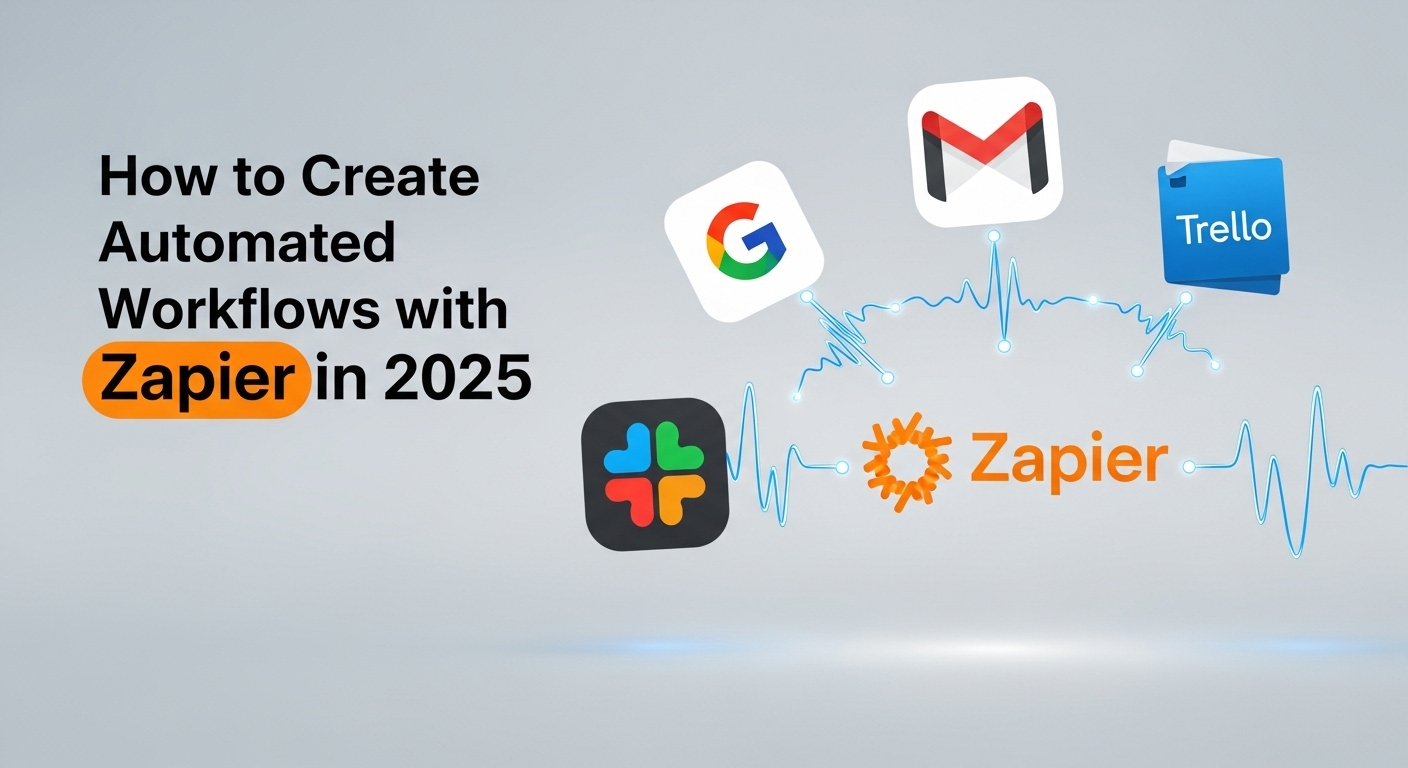Automated workflows with Zapier are sequences of actions that trigger automatically when specific conditions are met. These workflows, called “Zaps,” connect different applications and services without requiring any coding knowledge.
A typical Zap consists of:
- Trigger: The event that starts your automation
- Action: What happens when the trigger occurs
- Filters: Conditions that determine when actions should run
Why Use Automated Workflows with Zapier?
Building automated workflows with Zapier offers numerous advantages for businesses and individuals:
- Time Savings: Automations handle repetitive tasks instantly, freeing up valuable time for strategic work. Studies show that businesses save an average of 40 hours per month using workflow automation.
- Error Reduction: Manual data entry leads to mistakes. Automated workflows eliminate human error by transferring information accurately between systems.
- Improved Consistency: Workflows ensure processes happen the same way every time, maintaining quality standards across your operations.
- Better Integration: Zapier connects over 5,000 applications, enabling seamless data flow between tools that don’t naturally integrate.
Getting Started: Setting Up Your First Automated Workflow with Zapier
Step 1: Create Your Zapier Account
Visit Zapier.com and sign up for a free account. The free plan includes 5 Zaps and 100 tasks per month, perfect for beginners learning to create automated workflows with Zapier.
Step 2: Choose Your Trigger App
Select the application that will start your automation. Popular trigger apps include:
- Gmail
- Google Sheets
- Typeform
- Facebook Lead Ads
- Slack
Step 3: Configure Your Trigger Event
Specify exactly what event will start your workflow. For example, “New email in Gmail” or “New row added to Google Sheets.”
Step 4: Set Up Your Action App
Choose where you want the triggered data to go. Common action apps include:
- Salesforce
- Mailchimp
- Trello
- HubSpot
- Asana
Step 5: Test and Activate
Always test your Zap before going live to ensure it works correctly. Zapier provides sample data to help you verify everything functions properly.
7 Powerful Automated Workflows with Zapier Examples
1. Lead Generation Automation
- Trigger: New form submission on your website
- Action: Create contact in CRM + Send welcome email + Add to marketing list
This workflow captures leads instantly and begins nurturing them automatically.
Component | Tool | Function |
Form | Typeform/Gravity Forms | Capture lead info |
CRM | HubSpot/Salesforce | Store contact data |
Mailchimp/ActiveCampaign | Send welcome sequence |
2. Customer Support Ticket Management
- Trigger: New email to support address
- Action: Create ticket in help desk + Assign to team + Send auto-reply
This automation ensures no customer inquiry falls through the cracks.
3. Social Media Content Distribution
- Trigger: New blog post published
- Action: Share to Facebook + Tweet link + Post to LinkedIn + Add to Buffer queue
Maximize your content reach with automated social media distribution.
4. E-commerce Order Processing
- Trigger: New order in e-commerce platform
- Action: Create invoice + Update inventory + Send confirmation email + Add to fulfillment queue
Streamline your entire order fulfillment process.
5. Meeting Scheduling Automation
- Trigger: New calendar event created
- Action: Send meeting details to Slack + Create Zoom meeting + Add attendees to CRM
Keep your team informed about upcoming meetings automatically.
6. Project Management Workflow
- Trigger: New task created in project management tool
- Action: Assign team member + Set deadline + Send notification + Update project dashboard
Ensure projects stay on track with automated task management.
7. Financial Data Sync
- Trigger: New sale recorded
- Action: Update accounting software + Create invoice + Log in expense tracker + Generate report
Maintain accurate financial records without manual data entry.
Advanced Tips for Automated Workflows with Zapier
- Use Multi-Step Zaps: Premium plans allow multiple actions in a single workflow. Create comprehensive automations that handle complex business processes end-to-end.
- Implement Filters and Conditions: Add logic to your workflows using filters. For example, only create high-priority tickets for emails containing specific keywords.
- Leverage Webhooks: For advanced users, webhooks enable connections with applications not directly supported by Zapier, expanding your automation possibilities.
- Set Up Error Notifications: Configure alerts when workflows fail, ensuring you can quickly address issues and maintain smooth operations.
Common Mistakes to Avoid
- Over-Automating: Don’t automate everything immediately. Start with high-impact, repetitive tasks and gradually expand your automated workflows with Zapier.
- Insufficient Testing: Always test workflows thoroughly before activation. Incorrect automations can cause significant problems in your systems.
- Ignoring Data Privacy: Ensure your automated workflows comply with data protection regulations like GDPR and CCPA when handling customer information.
- Not Monitoring Performance: Regularly review your Zaps’ performance and optimize them for better efficiency and reliability.
Measuring Success with Automated Workflows
Key Metrics to Track
Metric | Description | Target |
Time Saved | Hours per week saved through automation | 10+ hours |
Error Rate | Percentage of tasks completed accurately | 99%+ |
Process Speed | Time from trigger to completion | Under 5 minutes |
User Adoption | Team members actively using workflows | 80%+ |
ROI Calculation
Calculate your return on investment by comparing the cost of Zapier subscriptions against the value of time saved and errors prevented.
Troubleshooting Automated Workflows with Zapier
Common Issues and Solutions
Zap Not Triggering
- Check trigger app permissions
- Verify trigger conditions are met
- Review connection settings
Data Not Transferring Correctly
- Map fields accurately between apps
- Test with sample data
- Check for formatting requirements
Actions Failing
- Verify action app permissions
- Ensure required fields are populated
- Check API rate limits
Best Practices for Automated Workflows with Zapier
- Document Your Workflows: Maintain clear documentation of all your Zaps, including their purpose, trigger conditions, and actions. This helps team members understand and maintain the automations.
- Regular Maintenance: Schedule monthly reviews of your automated workflows with Zapier to ensure they remain relevant and functional as your business evolves.
- Security Considerations: Regularly audit app permissions and remove access for applications you no longer use. Keep your Zapier account secure with strong passwords and two-factor authentication.
- Scalability Planning: Design workflows with growth in mind. Consider how increased volume will affect performance and plan for necessary upgrades.
Future of Automated Workflows with Zapier
Zapier continues innovating with new features like:
- AI-powered workflow suggestions
- Enhanced error handling
- Improved mobile app functionality
- Advanced analytics and reporting
These developments make automated workflows with Zapier even more powerful and user-friendly.
Getting Help and Resources
Learning Resources
- Zapier University – Comprehensive courses on automation
- Zapier Blog – Latest tips and best practices
- Zapier Community – User forums and discussions
Professional Support
For complex implementations, consider hiring a certified Zapier expert who can design and implement sophisticated automated workflows with Zapier tailored to your specific needs.
Conclusion
Creating automated workflows with Zapier transforms how you work by eliminating repetitive tasks and connecting your essential business tools. Start with simple automations like lead capture or email notifications, then gradually build more sophisticated workflows as you gain experience.
The key to success lies in identifying high-impact processes, testing thoroughly, and continuously optimizing your automations. With Zapier’s intuitive interface and extensive app ecosystem, anyone can build powerful workflows that save time and reduce errors.
Begin your automation journey today by identifying one repetitive task in your workflow and creating your first Zap. As you experience the time savings and improved efficiency, you’ll discover countless opportunities to streamline your operations with automated workflows with Zapier.
Remember that effective automation is an ongoing process. Regularly review and refine your workflows to ensure they continue delivering value as your business grows and evolves.











